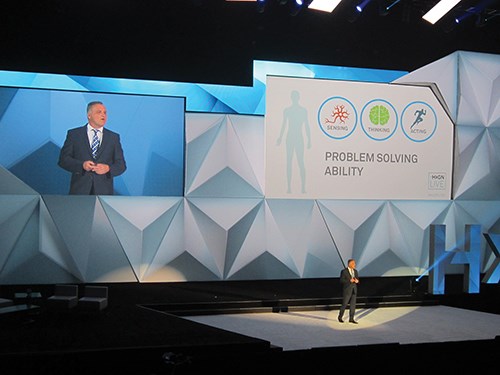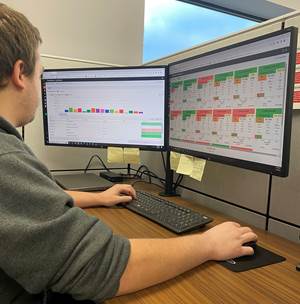Metrology Data in the Loop
Where will metrology fit in as the manufacturing industry moves quickly toward an environment that is driven by data and connected across the entire supply chain by a single “digital thread?” A good answer emerged at the recent HxGN Live event, which is the annual international conference sponsored by Hexagon, the global company best known in the manufacturing industry for its broad range of metrology equipment.
Share






At last month’s HxGN Live conference in Las Vegas, Norbert Hanke outlined how metrology must be an integral part of data-driven manufacturing concepts. As Hexagon Metrology president and CEO, he calls the “sensing, thinking, acting” capability of metrology systems an essential problem solving technology.
Where will metrology fit in as the manufacturing industry moves quickly toward an environment that is driven by data and connected across the entire supply chain by a single “digital thread?” A good answer emerged at the recent HxGN Live event, which is the annual international conference sponsored by Hexagon, the global company best known in the manufacturing industry for its broad range of metrology equipment.
This answer can be summed up by the theme for the metrology component of this conference as announced by Norbert Hanke, Hexagon Metrology president and CEO. Three words state this theme: “sensing, thinking, acting.” Proficiency in these three areas establishes metrology as the business of solving problems. This is much more than the activity of taking measurements, as some might narrowly define metrology.
In his keynote presentation, Mr. Hanke explained that sensing is at the heart of metrology equipment, whether by contact or non-contact techniques, or a unified combination of these methods. This “sensory input” represents the measurement of workpiece dimensions and feature characteristics. Thinking refers to the analysis of measurement data so that it becomes useful information to manufacturers. Software and software systems provide this analysis and reporting function. Finally, acting refers to the ability of shop and factory personnel to make decisions that ultimately improve the rate at which good parts are produced. Metrology, then, is a driver of productivity, not a barrier that consumes time and resources on the shop floor without delivering additional value. With its recent acquisition of Vero Software, Hexagon now offers CAM software products to make metrology data an essential driver of
shopfloor productivity.
When Steve Sivitter, CEO of Vero Software, joined Mr. Hanke on the stage, he explained how one of the key connections that enables metrology to drive productivity is CAM software. As the engine that drives CNC machine tools, CAM software is the logical agent by which metrology data can immediately influence the manufacturing process to ensure the production of parts that meet all dimensional specifications. Mr. Sivitter said that the range of Vero software brands, which includes Edgecam, Surfcam and WorkNC, now gives Hexagon a comprehensive path for looping metrology data securely into strategies for implementing data-driven manufacturing concepts.
Hexagon’s coverage of its other major information technology areas at the conference was also relevant to the vision of data-driven manufacturing that integrates metrology. The overarching concept that Hexagon sees as its contribution to the Internet of Things (whereby all devices are connected to other devices via a universal, Web-based network) is connecting the virtual world with the real world. Of course, the nature of this connection is to verify or validate that the virtual and the real have a truly functional match. To use an example drawn from manufacturing, how closely did we machine a workpiece (real world) to the tolerances specified in the digital model (virtual world)? Metrology satisfies that concern.
Hexagon can satisfy this concern in other realms, especially on a large scale: How closely can the wings of a jetliner be aligned so that mating them to the fuselage is smooth and secure? How closely is a building being constructed according to plan? How effectively has a mine been planned to fit the terrain with minimal environmental impact?
The concepts of closed-loop machining and in-process inspection are not new. Practical applications have been working reliably in machining systems for decades. What is new is the realization that this loop must pass through the digitally connected “manufacturing ecosystem,” thus enabling its closure to be verified, recorded, shared and made available to decision-makers who must act to avoid or resolve problems. Likewise, this looping and this closure must be built into every system in which the virtual and the real have counterparts that must match precisely. Hexagon, it seems, is positioning itself to see that this match truly measures up.
Related Content
Four Questions (& Answers) About Data-Driven Process Improvement at CNC Job Shops
How can shops can make informed decisions using data-driven feedback to improve shopfloor efficiency and profitability? And how will these technologies differ between high- and low-volume production?
Read MoreSwiss-Type Control Uses CNC Data to Improve Efficiency
Advanced controls for Swiss-type CNC lathes uses machine data to prevent tool collisions, saving setup time and scrap costs.
Read MoreGive Job Shop Digitalization a Customer Focus
Implementing the integrated digital technologies and automation that enhance the customer's experience should be a priority for job shops and contract manufacturers.
Read MoreMachine Monitoring Boosts Aerospace Manufacturer's Utilization
Once it had a bird’s eye view of various data points across its shops, this aerospace manufacturer raised its utilization by 27% in nine months.
Read MoreRead Next
5 Rules of Thumb for Buying CNC Machine Tools
Use these tips to carefully plan your machine tool purchases and to avoid regretting your decision later.
Read MoreSetting Up the Building Blocks for a Digital Factory
Woodward Inc. spent over a year developing an API to connect machines to its digital factory. Caron Engineering’s MiConnect has cut most of this process while also granting the shop greater access to machine information.
Read MoreBuilding Out a Foundation for Student Machinists
Autodesk and Haas have teamed up to produce an introductory course for students that covers the basics of CAD, CAM and CNC while providing them with a portfolio part.
Read More






























